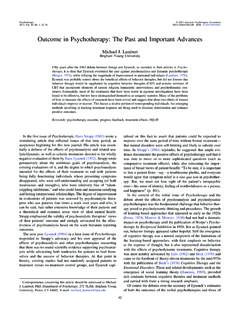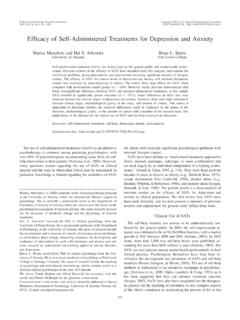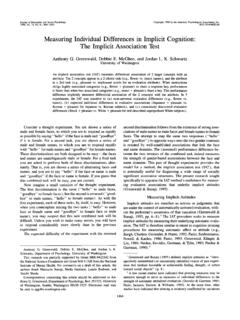Transcription of Serial Murder in America: Case Studies of Seven Offenders
1 Behavioral Sciences and the LawBehav. Sci. Law22: 395 414 (2004)Published online in Wiley InterScience ( ). DOI: Murder in America: CaseStudies of Seven OffendersJames O. Beasley II, , *This article summarizes and compares information onseven interviewed Serial killers in an ongoing projectdesigned to study similarities and differences amongthese individuals. The aim of this article is to increaseour collective knowledge of the dynamics of Serial murderby examining the perpetrators backgrounds, as well as theunique ways in which they view themselves and the worldaround them. Although qualitative interview researchalone is not sufficient to fully understand such behavior,it is useful in many ways. Some of the informationdiscussed based on the Seven Offenders interviewed iscompared with broader epidemiological Studies , and thestrengths and limitations of each type of research arediscussed.
2 Published in 2004 by John Wiley & Sons, initial FBI study on sexual homicide and crime scene analysis, which includedinterviews with 25 Serial murderers by the Behavioral Science Unit (BSU) at theFBI Academy in Quantico, Virginia, was published nearly 20 years ago (The MenWho Murdered, 1985). Since then, the phenomenon of Serial Murder has beenmythologized in popular culture, sensationalized by the media, and increasinglyscrutinized by academia. The results have been confounding, with fiction blurringwith fact, and assumptions and guesses often treated as certainty. Many of thesemisperceptions are associated with the technique of profiling, which involvesassessment of crime scenes to construct a set of behavioral traits likely to be foundin a particular offender. Even today there is a common belief that profiling is analmost mystical experience, and that it is always accurate and clear cut.
3 However,violent criminal behavior is extremely variable, making precise predictions proble-matic. Some researchers have addressed the issue of predictability, among themFarrington (1982); Goldberg (2000); Gottfredson and Hirschi (1990); andMalmquist (1996).Notwithstanding some acceptance of the notion of past violent behaviors beingpredictive of future such behaviors (Samenow, 1998; Widom & Toch, 2000),there exists an abundance of psychological theories about criminal behavior thatare varied and sometimes conflicting (Hall, 1999; Widom & Toch, 2000). As Foxand Levin (2001) have warned, correlation does not imply causation, andThis article is a Government work and is in the public domain in the *Correspondence to: James O. Beasley II, , , Supervisory Special Agent, National Center forthe Analysis of Violent Crime, FBI Academy, Quantico, VA 22135, : correlation also does not guarantee predictability (pp.)
4 26 28). Based partly onthese predictability issues, some academics have raised concerns over the validity ofprofiling, and have called for more empirical research (Homant & Kennedy, 1998;Kocsis, Hayes, & Irwin, 2002). Some have gone further, criticizing perceivedshortcomings of early profiling research findings and resulting procedures (Egger,1998), including some done by the FBI (Godwin, 2000). Others (Holmes &Holmes, 2002) have noted the failure of FBI researchers to disclose their metho-dology regarding interviews of some of the prominent killers in their Serial Murder and profiling have become so fixed within our national psychesuggests that these subjects serve, even when true, as more than unique criminalbehaviors and an associated investigative tool; they have entered the realm ofentertainment (Tithecott, 1997). Narratives and descriptions of these crimes andthose who commit them seem to horrify, to challenge, and to satisfy our morbidcuriosity.
5 Commentary about these individuals often includes large doses ofmelodrama. Tithecott (1997) quotes the lawyer for Serial killer Jeffrey Dahmer,who referred to Dahmer as a steamrolling killing machine, and a runaway trainon a track of madness (p. 96).The original findings of the FBI s BSU were based on a small sample size 36subjects, of whom 25 were classified as Serial killers. To this day, early insights intothe behavior of those sexual murderers provide a basis for behavioral profiles ofunknown Offenders . They remain a key element of the expanded criminal investi-gative analysis services offered by the FBI s National Center for the Analysis ofViolent Crime (NCAVC), the unit responsible for operational analytical assistancewithin the Critical Incident Response Group (CIRG). These services go beyondprofiling, and include consultations on investigative procedures, interview techni-ques, forensic considerations, media relations, behavioral analysis regarding victimsand Offenders , trial strategies, expert testimony, and data collection and profiles, the NCAVC has recognized a need for more current research,as well as caution in the use of these products.
6 In concert with the NCAVC, Witte(unpublished doctoral dissertation) studied Serial Murder in general, while Dudekfocused on Serial versus single homicides among prostitute has encountered other challenges as researchers have sought to providesupport for its procedures and document its successes and failures (Pinizzotto &Finkel, 1990). A recent study has suggested that investigative experience does notnecessarily confer an enhanced ability to profile Serial murderers (Kocsis et al.,2002). Other inquiries into the efficacy of profiling have been made by Alison,Bennell, Mokros, and Ormerod (2002), Homant and Kennedy (1998) and Wilson,Lincoln, and Kocsis (1997).The NCAVC s Child Abduction and Serial Murder Investigative ResourcesCenter (CASMIRC) was formed in early 2000 based on a Congressional mandate(Protection of Children From Sexual Predators Act, 1998).
7 Ongoing CASMIRC research in the NCAVC includes epidemiological Studies on child abduction(Boudreaux, Lord, & Dutra, 1999) and child homicide (Boudreaux, Lord, & Jarvis,2001), interviews of convicted child abductors who killed their victims (Beyer &Beasley, 2003), and detailed review of investigative files. In order to update the dataon Serial Murder , a related project is underway that includes interviews of Offenders ,along with reviews of case files. In this study, interviews have been conducted with20 Serial killers in five O. BeasleyPublished in 2004 by John Wiley & Sons, Sci. Law22: 395 414 (2004)This interview-based, qualitative research aims to deepen our knowledge of thedynamics of Serial Murder by examining first-hand the unique ways in which theseoffenders view themselves and the world. Admittedly, offender interviews alone donot result in a complete understanding of Serial homicide.
8 Still, individual casestudies provide a valuable way to learn about unusual populations such as interviews do have some drawbacks. Among these are subject acquisitioncriteria that rely on self-selection, reliability of information based on self-report, andthe amount of time required collecting and verifying data. It is believed by thisauthor, however, that a comprehensive expertise and understanding of the serialhomicide phenomenon can best be obtained through extensive, systematic, anddirect contact with persons who exhibit these behaviors, coupled with empirical dataderived from larger (2001), for one, has stressed the need to explore Serial Murder though in-depth, one-on-one interviews with Offenders . This type of qualitative research,though time consuming, is valuable in that it provides personal, detailed knowledgeand a descriptive element not found in quantitative research.
9 Still, it has its placealongside epidemiological Studies that have larger populations but may not provideas much in-depth information. One of the strengths of these epidemiological studiesis that they have examined factors that have some predictive value (Witte, 2000).Together, interview research and epidemiological research, each with its uniquestrengths and limitations, provide a more complete picture of Offenders and thedynamics of their purpose of this article is to review and compare information obtained onseven Offenders interviewed and studied to date. These killers individually revealedsome rather distinct variations, and a few similarities in their offenses. The facts oftheir crimes and their commentaries are not meant to broadly categorize, but ratherserve a more descriptive purpose, and to demonstrate their unique backgrounds andbehaviors. Because this is a small sample, the generalizability of what they reported,even when verified through comparison to case records, is problematic.
10 It is intended,however, that these findings will ultimately provide support and further considera-tion for some of the assistance that the NCAVC offers in ongoing, unsolved of this author s NCAVC colleagues who are involved in assessing offendersin pending cases will readily acknowledge that while qualitative interview researchfocused on case Studies is helpful, each new case that is analyzed must be examinedindividually and carefully, and that making judgments based on comparison withsmall populations is risky. Furthermore, reaching conclusions and affixing labels toindividuals and situations without thorough and detailed examination of the factscan easily result in unhelpful, misleading, or erroneous outcomes. This note ofcaution should apply in any study of a limited number of subjects. In this article, thecases chosen are intended to demonstrate the wide variances in behaviors that oftenpresent difficult challenges for those who attempt to analyze such behaviors inunsolved PROCESSThe Seven Offenders selected for this review were identified from the 20 interviewedto date.










